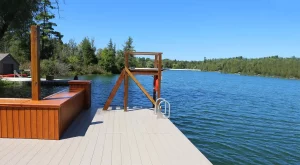Welcome to the Residential Dock Installation Guide, your go-to resource for installing and crafting your own residential dock. Whether you’re a beginner or have some construction experience, this guide will cater to all skill levels and ensure a successful installation process.
Through our visual walkthrough, we’ll guide you step-by-step, providing detailed illustrations and diagrams. From selecting the right materials to mastering essential tools and techniques, you’ll gain the knowledge and confidence to transform your waterfront property into a stunning and functional space.
Join us on this exciting journey of residential dock installation and crafting, as we help you create a beautiful and inviting space that truly reflects your personal style.
Key Takeaways
- The choice of dock materials greatly affects durability, maintenance, and appearance, with options including pressure-treated wood, composite decking, and aluminum.
- When planning the layout and design of a residential dock, it is important to consider the purpose, assess the waterfront conditions, maximize space, and ensure accessibility and safety features.
- Proper site preparation involves clearing debris, leveling and grading the site, assessing water depth and soil conditions, and ensuring proper drainage.
- During dock structure installation, it is crucial to choose the appropriate foundation type, securely anchor the foundation, select strong and durable materials, and follow manufacturer’s instructions for proper installation techniques. Regular inspections, cleaning, and maintenance are also important for preventing damage and prolonging the dock’s lifespan.
Choosing the Right Dock Materials
When it comes to residential dock installation, one of the crucial decisions to make is choosing the right dock materials. The choice of materials greatly affects the durability, maintenance, and overall appearance of the dock.
For a long-lasting and sturdy dock, it is essential to select materials that can withstand the harsh outdoor elements such as water, sunlight, and fluctuating temperatures.
Common materials used for residential docks include pressure-treated wood, composite decking, and aluminum. Pressure-treated wood is a popular choice due to its affordability and natural look, but it requires regular maintenance to prevent rot and decay.
Composite decking, on the other hand, offers low maintenance and durability, as it is resistant to moisture, mold, and insects. Aluminum docks are known for their lightweight and corrosion-resistant properties, making them ideal for saltwater environments.
Considering factors such as budget, aesthetics, maintenance requirements, and durability will help homeowners choose the right dock materials that meet their needs and provide a sense of belonging to their waterfront property.
Planning the Layout and Design
To ensure a well-organized and functional residential dock, meticulous planning and thoughtful design are essential. The layout and design of the dock should be carefully considered to optimize its functionality and aesthetic appeal. Here are some key points to keep in mind when planning the layout and design of your residential dock:
- Consider the purpose: Determine how you intend to use the dock, whether it’s for recreational activities like swimming and fishing or for boat docking and storage.
- Assess the waterfront: Take into account factors such as water depth, current, and shoreline conditions to determine the best location and orientation for your dock.
- Maximize space: Optimize the available space by considering the size and type of boats or watercraft you plan to use, as well as any additional features like seating areas or storage.
- Ensure accessibility: Plan for easy access and maneuverability on the dock, taking into consideration ramps, stairs, and handrails for safe and convenient use.
- Incorporate safety features: Install safety measures such as lighting, cleats, and bumpers to ensure the well-being of users and protection of the dock structure.
Preparing the Site for Dock Installation
To ensure a smooth and successful residential dock installation, proper site preparation is crucial. Before beginning the installation process, it is important to carefully evaluate the site and make necessary preparations.
The first step is to clear the area of any debris, vegetation, or obstacles that could interfere with the dock’s placement. This includes removing rocks, tree stumps, and any other potential hazards.
Next, the site should be leveled and graded to ensure a stable foundation for the dock. This may involve filling in low-lying areas or removing excess soil.
Additionally, it is essential to assess the water depth and consider factors such as tides, currents, and erosion.

Installing the Dock Structure
How can the dock structure be properly installed for a residential dock installation? Installing the dock structure is a crucial step in ensuring the stability and durability of your residential dock.
Here are some key considerations to keep in mind:
- Foundation:
- Choose the appropriate foundation type, such as pilings or floating pontoons, based on the water depth and soil conditions.
- Ensure the foundation is securely anchored to provide stability and prevent shifting or sinking.
- Frame and Decking:
- Select a strong and durable material for the frame, such as pressure-treated wood or aluminum.
- Use high-quality decking material that is resistant to water damage, UV rays, and slipping.
Finishing Touches and Maintenance Tips
After properly installing the dock structure for your residential dock, it is important to focus on the finishing touches and maintenance tips to ensure its long-term functionality and appeal.
The finishing touches involve adding elements that enhance the dock’s aesthetics and functionality. This includes installing railings, lighting fixtures, and benches. Railings not only provide safety but also add a decorative element to the dock. Lighting fixtures ensure visibility during nighttime use and create a pleasant ambiance. Benches offer a comfortable seating option for relaxation and enjoyment of the waterfront view.
In terms of maintenance, regular inspections should be conducted to check for any damage or wear and tear. It is also crucial to clean the dock regularly, removing debris, algae, and other contaminants. Applying a protective coating or sealant can help prolong the lifespan of the dock by preventing water damage and rot.
Frequently Asked Questions
How Much Weight Can a Residential Dock Support?
A residential dock is designed to support a certain amount of weight based on its construction and materials used. Factors such as the type of dock, its size, and the materials used will determine the maximum weight it can support.
What Permits or Permissions Are Required for Dock Installation?
Permits and permissions required for residential dock installation vary depending on location and local regulations. It is important to consult with local authorities or a professional dock installer to ensure compliance with all necessary requirements.
Are There Any Specific Regulations or Guidelines for Dock Installation in My Area?
Specific regulations and guidelines for dock installation vary by area. It is important to research and consult local authorities to ensure compliance with any permits, zoning requirements, environmental regulations, and safety standards that may apply.
Can I Install a Dock in a Shallow Water Area?
Yes, it is possible to install a dock in a shallow water area. However, specific guidelines and regulations may vary depending on your location. It is important to consult local authorities and experts to ensure compliance and safety.
What Are the Maintenance Requirements for a Residential Dock?
Maintenance requirements for a residential dock include regular inspections for damage, cleaning of debris, and treating the wood for protection against rot and pests. Additionally, periodic resealing or repainting may be necessary to maintain the dock’s appearance and durability.
Conclusion
In conclusion, this comprehensive guide on residential dock installation and crafting has provided a detailed and technical walkthrough of the entire process.
From selecting the right materials to understanding the essential tools and techniques, this guide ensures that readers of all skill levels can successfully install and craft their own residential dock. By following the step-by-step instructions and incorporating the provided tips and maintenance advice, readers can transform their waterfront property into a functional and visually appealing space.
You May Also Like:




